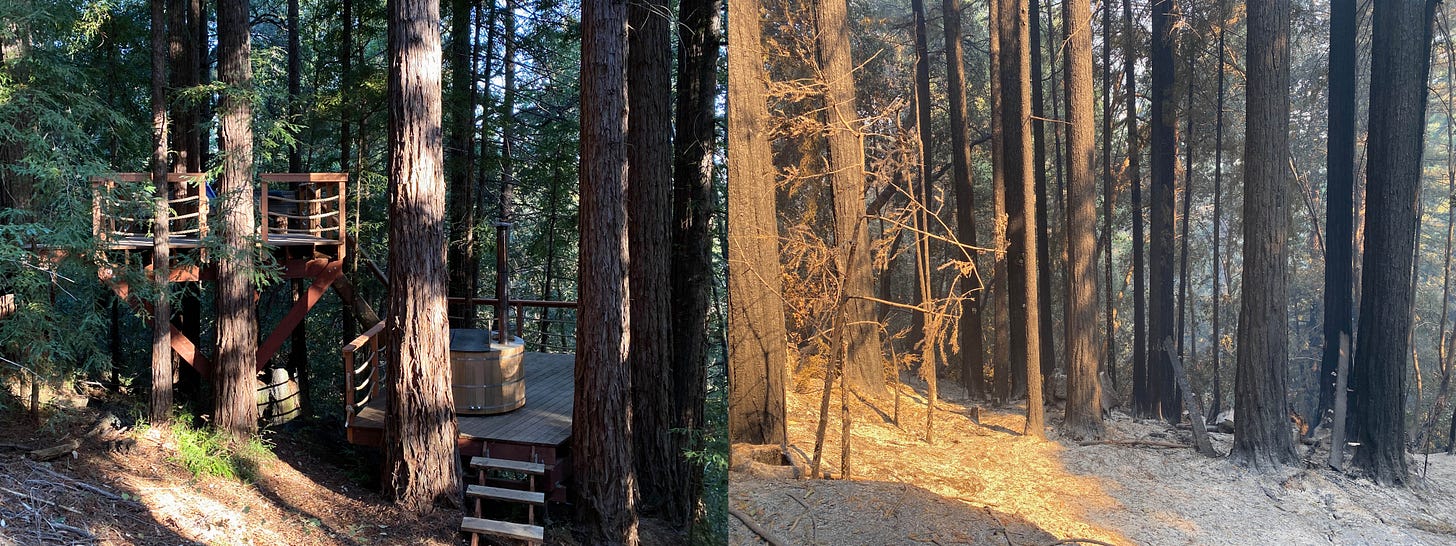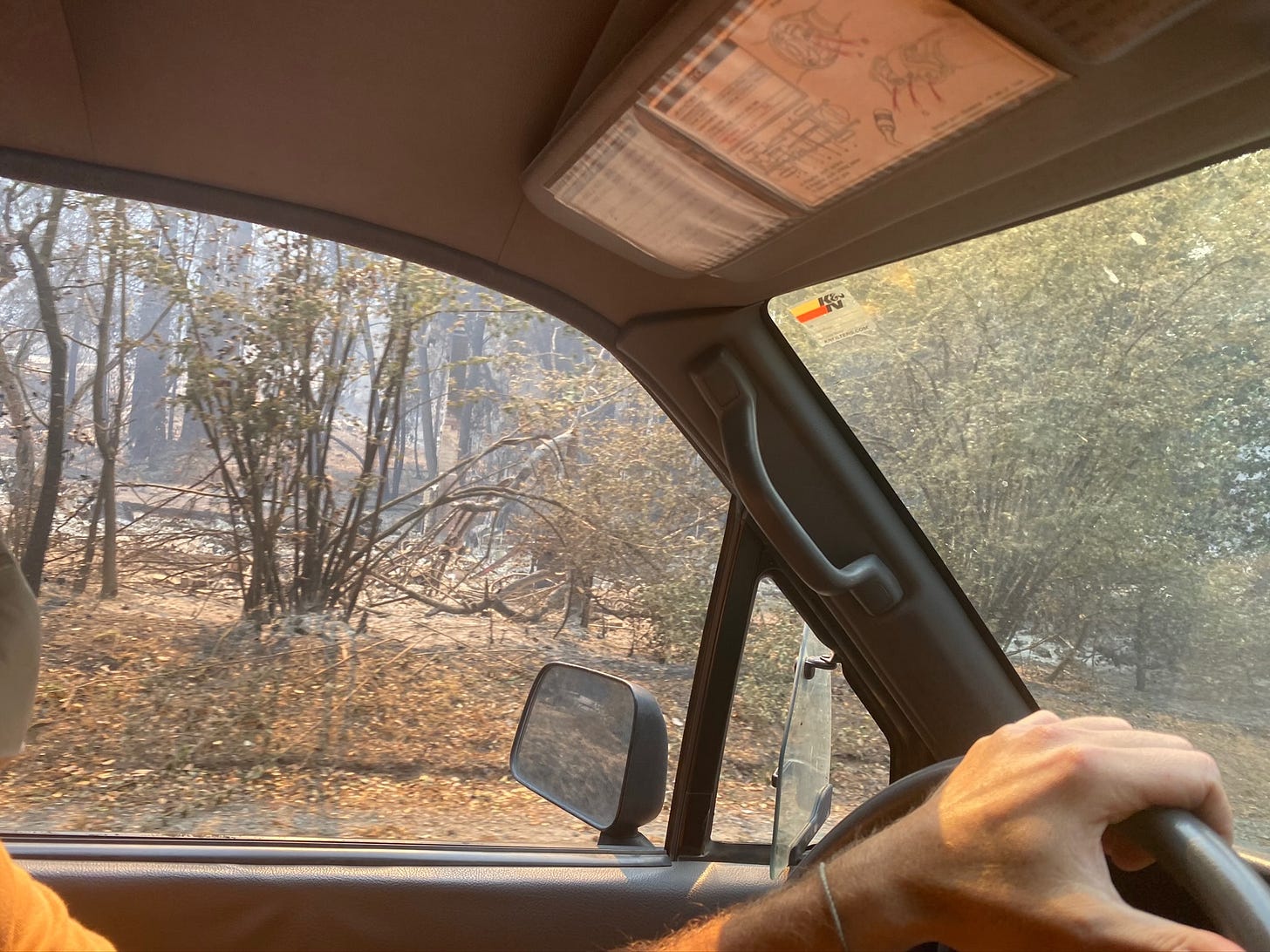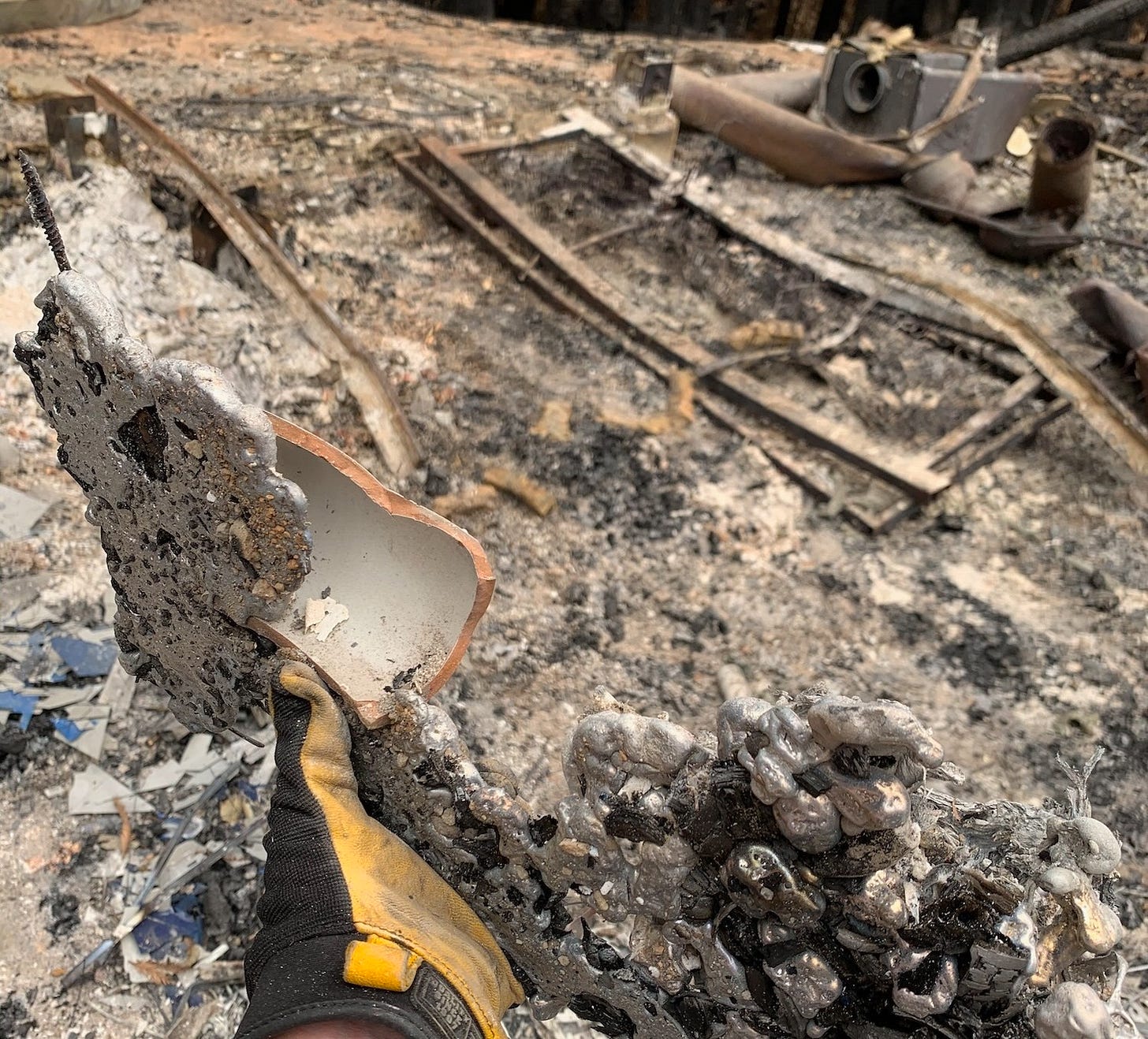I’ve referenced the fire that scorched our property a handful of times, but I’ve never written about it directly, so I thought I’d give a bit more texture to that story.
The basic arc of our land was this: Molly and I bought it in 2016. With the help of a lot of friends we turned it into a pretty rad communal space. We’d hang, build, host events… real adult summer camp energy. There was a cabin, glamorous outhouse, archery, axe throwing, a few decks suspended up in the trees, a wood-fired hot tub, and a bitchin’ shower. All this was nestled in a thick forest of redwood, fir, oak, and madrone and every bit was constructed by us and our friends.
Unfortunately, four years in, a wildfire came through and deleted all that. Not great.
That said, it can’t be overstated how much that period shaped Molly and I and informed our trajectories and identities—and just how little of that was lost to the fire. The value really was in the experience. So, there’s that.

As for the fire…
On August 16th, 2020, a dry thunderstorm sparked ten thousand lighting strikes in the mountains around our plot, igniting 22 fires that eventually merged into one which burned for a month. With decades of fire suppression and an aversion to prescribed burns, there was no shortage of fuel in the region. (Years of Sudden Oak Death contributed, as tanoak leaves are rich in wax and oil.) Winds rose to 75 mph. 86,000 acres and a thousand structures burned. Temperatures hit 1600 degrees and turned soil to glass.1 But all that hardly ranks our fire among California’s worst. We’ve had a lot.
A few days after the fires kicked off, the flames reached our property and I think we can all agree that this was objectively the worst thing to happen in 2020.
As the fire burned, Molly and I didn’t actually know how impacted our property was. We had tried to grab a few things from the cabin the night of August 18th, just as the evacuation orders were coming in. But embers raining down in advance of the flames had started a fire at our neighbors house and made our narrow and wooded road a deathtrap. Seeing this, we retreated to flag down a nearby fire truck and let them know about the neighbor’s blaze2, then headed back to the city with the orange glow over the mountains in the rearview.
Reports over the next few days were unclear and curiosity eventually got the better of me, so my friend Darren and I drove in to take a look on August 21st. We wore masks and drove with the windows down, as was the fashion of the time.
The damage we passed was, at first, random. Cruelly so, I imagined, to folks who would inevitably return to find their home burned down to the foundation and flanked by unscathed neighboring houses.
The woods became more evenly devastated as we neared the property and eventually we were halted by downed trees and power lines. We’d have to hike in the last mile, and with small fires still burning, leaving the truck felt dicey. I parked in a spot where my wheels seemed less likely to ignite and Darren and I decided to make a quick trip of what seemed a likely formality.

As suspected, we found everything was torched. All the structures were gone. Undergrowth was largely eliminated. Small trees had mostly vanished, or at least seemed pretty damn dead, though larger trees—especially redwoods—survived due to their bulk and protective bark.

In many areas the fire had ascended in the canopy and this proved ultimately fatal for much of the foliage—especially for the tanoak and doug fir. I’d estimate that close to half of all trees we found standing at the time were killed.
These canopy fires are where frequent and smaller burns, and a thinned undergrowth (aka your fire ladder), would have shown their value. A burning understory doesn’t devastate and radically reshape a mature forest the way a roasted canopy does. (Our spot fared comparatively well and bounced back after a couple of years, but there are sections of this particular fire that saw total canopy loss and still show a complete destruction of the forest.)
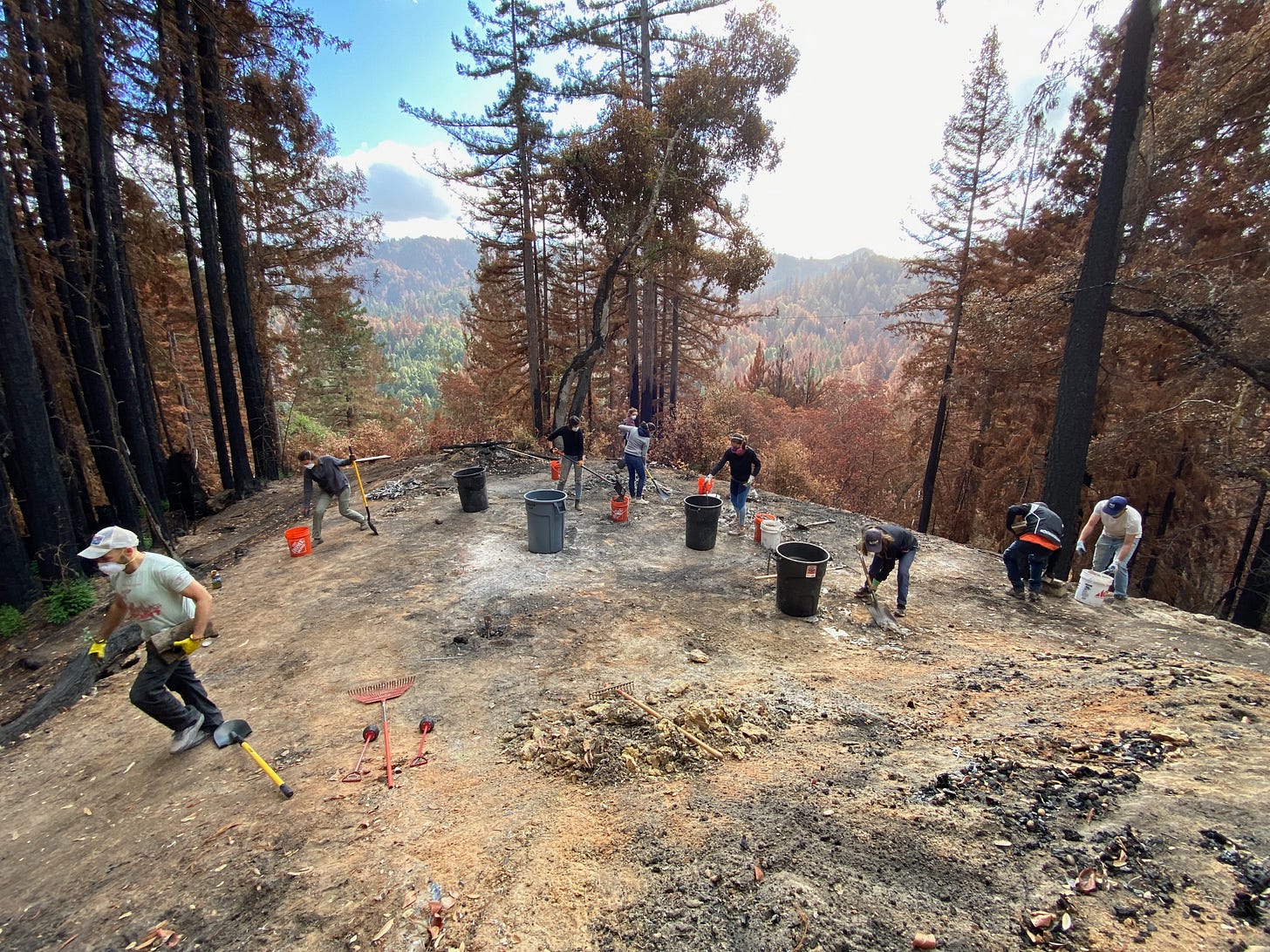
Cleanup on the property took place over the following months and was in some ways more demoralizing than the fire. Had everything just been gone, that would be one thing. But it took a 20-yard dumpster and weeks of work by a lot of friends to remove all the metal roofing, nails, concrete crumbles, and odds and ends like mangled wood stoves and melted window frames.
It wasn’t all a bummer though. Sebastien honored us with this moment when trying to prove the value of a running wheelbarrow start:
Now, you might be thinking, those pre-fire woods look pretty lush and could stand to have been thinned. And you did build stuff out of dry lumber right in the thick of all that growth...
100%.
We bought what we could afford, which was a very sloped chunk of dirt tucked at the end of a wily road, backed up to wilderness, with a meager water supply. It wasn’t practical to clear defensible space 100 feet from our structures, nor did we particularly want to. If a fire came through those woods we wouldn’t be able to do much about it and fire crews certainly wouldn’t be defending it. So we were always aware of the risks and were accepting of them with our (relatively) lower-cost investment. Still stings though.

It’s been interesting to watch the land shift and recover over the past several years.3 The woods thinned, and what was once a very compartmentalized and shaded space became a bit more, um… open concept. The newts are gone, but other wildlife—notably quail and turkey—has returned in greater numbers. The canopy is beginning to fill in, but the bulk of regrowth lives in a bursting understory of redwood and tanoak basal sprouts, and pioneer plants such as California lilac (Ceanothus), whose seeds have sat dormant and waiting a hundred years for this exact opportunity.
For a time it was exciting to embrace any green we could get, but it’s now grown so thick that we’re working on a plan to cut it all back.
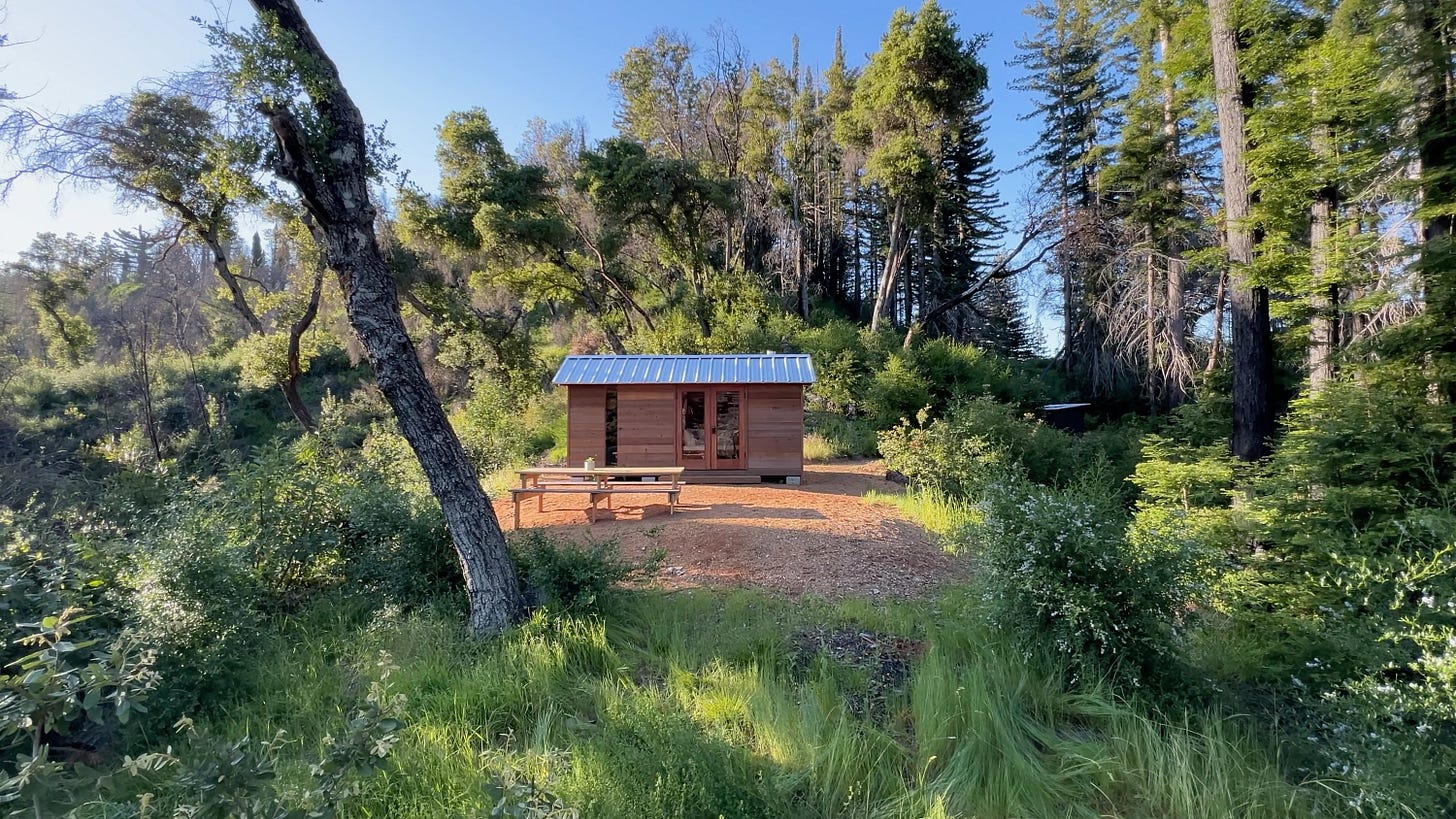
My buddy Ryan quotes me here when speaking to the author of Fire Weather, John Valliant4, about my viewing the property and loss as a sort of mandala.
I stand by it. I mean, I sure wouldn’t choose to burn the place to the ground. And the hit absolutely impacted our relationship with the property and diminished the scope of our post-fire building aspirations.5 But if not for the fire we wouldn’t have a fresh cabin which I’m more proud of, in many ways, than the one which previously stood in its place.
And it bears repeating that the experience has been worth so, so much more than the stuff it produced. But still… it stings.
DIRECT TO YOUR INBOX
NEW TO THE NEWSLETTER? TO BUILDING?
Start with these posts on Project Planning and Construction Basics.
Or these posts on Community Building.
Or browse. Posts wander from friendship, to workshops, to tools, to explosives. Because we contain multitudes.
elevatedspaces.ca | Instagram | YouTube
The handles melted off our cast iron pans.
The fire crew put out that blaze and posted up to protect the neighbor’s house for the duration of the fire.
“Recover” is one word for it. Seemingly healthy trees have toppled while experiencing new wind forces and eroding soil. Landslides are also pretty common. But things are finally evening out after a tumultuous first few years.
Excellent book. Even better is his book The Tiger.
Post-fire builds experimented with minimal construction and an outlook of “This might burn down again, so let’s not try too hard” which is equal parts trauma response and learning opportunity. The lessons learned in that new approach and in cutting corners, merits its own post.




